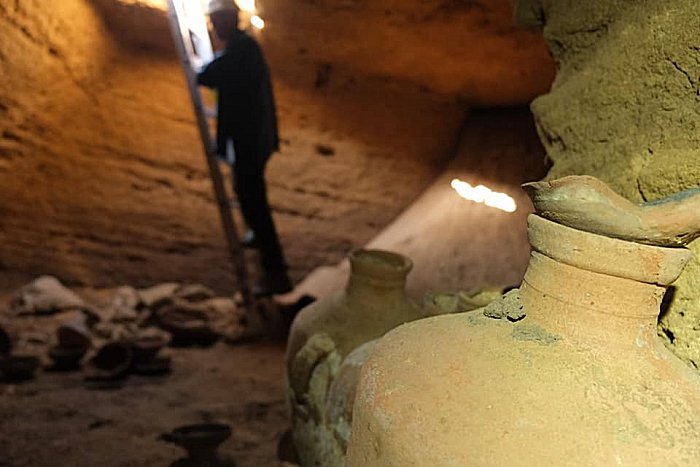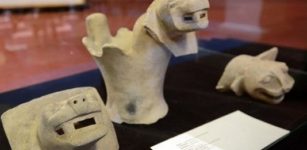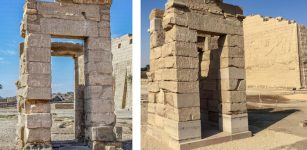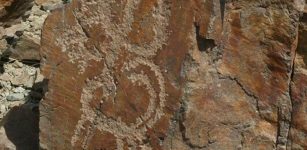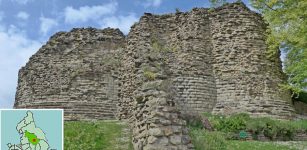Man-Made Square Burial Cave Dated To Rameses II-Era Accidentally Found In Israel
Conny Waters - AncientPages.com - A man-made square burial cave dated to the time of ancient Egyptian Pharaoh Rameses II and associated with the Biblical Exodus from Egypt was accidentally discovered during a mechanical digger working at the Palmahim Beach National Park in Israel.
 The vessels were burial offerings that accompanied the deceased in the belief that they would serve the dead in the afterlife. Image credit: Israel Antiquities Authority
The vessels were burial offerings that accompanied the deceased in the belief that they would serve the dead in the afterlife. Image credit: Israel Antiquities Authority
To reach this "frozen in time" cave, archaeologists had to use a ladder to descend it, Israel Antiquities Authority informed.
The hewn cave was square in form with a central supporting pillar. Several dozens of intact pottery and bronze artifacts were lain out in the cave, exactly as they were arranged in the burial ceremony, about 3,300 years ago.
These vessels were burial offerings that accompanied the deceased in the belief that they would serve the dead in the afterlife.
“This is a once-in-a-lifetime discovery! A cave floor laid out with vessels untouched for 3,300 years, since the Late Bronze Age, about the time of the powerful King Rameses II," said Dr. Eli Yannai, Israel Antiquities Authority Bronze Age expert, said Dr. Eli Yannai, Israel Antiquities Authority Bronze Age expert.
Image credit:
"The fact that the cave was sealed, and not looted in later periods, will allow us the employ the modern scientific methods available today, to retrieve much information from the artifacts and from the residues extant on the vessels, for example, organic remains that are not visible to the naked eye.
The cave may furnish a complete picture of the Late Bronze Age funerary customs," he added.
The burial cave included dozens of bronze artifacts and pottery vessels, such as deep and shallow bowls, some red-painted, footed chalices and storage jars, some imported from the Lebanese coast.
Additional smaller vessels, mainly jugs and juglets, used to store and trade smaller quantities of expensive commodities, were imported from Tyre, Sidon, and other ports along the coast of Lebanon and Israel, whilst dome8 pottery vessels came from Cyprus.
Image credit:
“The finds in the cave date to the thirteenth century BCE (Late Bronze Age IIB)” says Dr. Yannai.
“In this period, in the long reign of the Nineteenth Egyptian Dynasty Pharaoh Rameses II, the Egyptian Empire controlled Canaan, and the Egyptian administration provided secure conditions for extensive international trade".
The discovery in the Palmahim National Park is unique and absolutely astonishing," commented Eli Eskosido, Director of the Israel Antiquities Authority, and Raya Shurky, the Director of the Israel Nature and Parks Authority,
The news of the discovery of the cave spread like wildfire in the academic world, and we have already received requests from many scholars to take part in the planned archaeological excavation. Unfortunately, despite the guard set up, a few items were looted from the cave before it was sealed up, an issue that is now under investigation.
Within a few days, we will formulate a plan to carry out the research and the protection of this unique site, which is a feast for the archaeological world and for the ancient history of the land of Israel.”
Written by Conny Waters - AncientPages.com Staff Writer

